Vaccine Statistics – By Demographic, Type, State, Purpose, Exports, Country and Imports
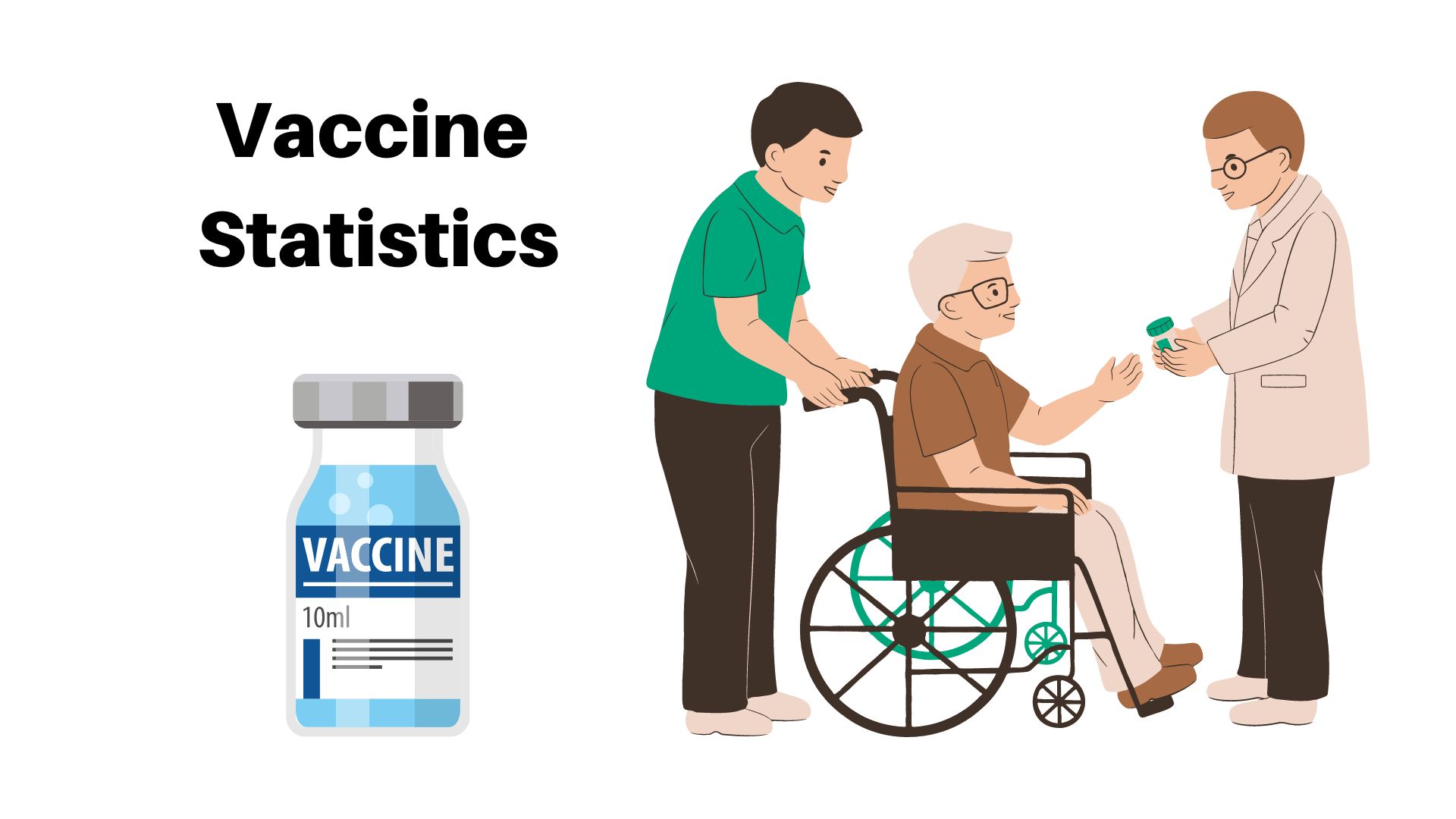
Page Contents
- Introduction
- Editor’s Choice
- What is a vaccine?
- General Vaccine Statistics
- Vaccine Statistics By Demographic
- Vaccine Statistics By State
- Vaccine Statistics By Type
- Vaccine Statistics By Purpose
- Vaccine Statistics By Exports
- Vaccine Statistics By Imports
- Vaccine Statistics By Country
- Vaccine Statistics By Industry
- Conclusion
Introduction
Vaccine Statistics: There are various types of vaccines around the globe available for every disease. Some vaccines are meant to be given at an early stage of life to stop the disease from developing in the body in the future. Since COVID-19, the delivery of doses has increased drastically around the world.
These Vaccine Statistics have been represented with recent data collected from various types of segments. These statistics are mainly focused on COVID-19 due to recent events.
Editor’s Choice
- On a global average, 11.2 billion COVID-19 vaccines were produced by the year 2021.
- As of February 2023, in high-income countries, 3 in 4 people, resulting in 73% have been vaccinated with at least the first dose.
- As per the Vaccine Statistics, the majority of the people who are not vaccinated live in Africa and South Asia.
- Every day, 628,762 vaccine doses are observed.
- Vaccines can prevent around 2,500,000 deaths each day.
- According to the Vaccine Statistics, every year, around the globe, 3,00,000 lives are saved due to vaccines.
- Around the globe, 13.31 billion doses have been observed.
- As of today, around the world, 2.3 billion people are yet to get vaccination which results in 52% of unvaccinated people.
- The effectiveness of vaccines is found in 85% to 99% of people.
- 69.7% of the world population has at least taken one dose of the COVID-19 vaccine, out of these 27.7% of vaccine takers are from low-income countries.
What is a vaccine?
A vaccine is referred to as a biological preparation that delivers active acquired immunity for specific infections or diseases. The vaccine is more effective in widespread diseases. According to the WHO – World Health Organization, licensed vaccines are available for different 25 infections. Once the vaccine is inserted in the body, the immune system identifies it as foreign, then destroys the infections and remembers the agents, for further healthy development.
General Vaccine Statistics
- Other than COVID-19 Vaccine only 25 other vaccines are reported in the year 2021.
- Vaccines can prevent around 2,500,000 deaths each day.
- On average vaccine needs 12 years to get developed.
- According to the Vaccine Statistics, every year, around the globe, 3,00,000 lives are saved due to vaccines.
- The effectiveness of vaccines is found in 85% to 99% of people.
- Around the globe, 13.31 billion doses have been observed.
- Every day, 628,762 vaccine doses are observed.
- According to the Vaccine Statistics, 69.7% of the world population has at least taken one dose of the COVID-19 vaccine, out of these 27.7% of vaccine takers are from low-income countries.
- As of February 2023, in high-income countries, 3 in 4 people, resulting in 73% have been vaccinated with at least the first dose.
- Similarly, around 31.51% of the population resulting in 1 in 3 people in low-income countries have been vaccinated with the first dose.
- On the average cost of vaccinating 70% of the population around the globe, people increased their healthcare spending by 0.8% in high-income countries, and 56.6% in low-income countries.
- On a global average, 11.2 billion COVID-19 vaccines were produced by the year 2021.
- As of today, around the world, 2.3 billion people are yet to get vaccination which results in 52% of unvaccinated people.
- As per the Vaccine Statistics, the majority of the people who are not vaccinated live in Africa and South Asia.
Vaccine Statistics By Demographic
By Gender

(Source: morningconsult.com)
- As of February 2023, 69% of the female population has been vaccinated, while 2% are planning to get vaccinated.
- 5% of females are uncertain about getting immunization and 24% are unwilling to take it.
- On the other hand, 73% of the male population around the globe is already vaccinated and 3% is planning to get vaccinated.
- 5% of the male population around the world is uncertain and 20% are unwilling towards it.
By Ethnicity

(Source: morningconsult.com)
- 72% of people with white population have been vaccinated while 2% of them are planning to get vaccinated, 4% are uncertain and 23% are unwilling.
- There are 63% of people from a black background, out of which 6% are planning to get vaccinated, 7% are uncertain and 24% do not want to get vaccinated.
- Hispanic groups represent 69% vaccinated population, 3% are planning to get vaccinated and 6% are uncertain and 22% are unwilling to get immunized.
By Age

(Reference: morningconsult.com)
- Around the world, 59% of the people who are vaccinated are from the age group of 18 years to 34 years. Furthermore, in a similar age group, 4% are planning to get vaccinated, 8% are uncertain and 28% are unwilling towards it.
- 64% of people from the age group of 35 years to 44 years are vaccinated and 3% are planning to get immunized. 5% of them are uncertain and 28% are unwilling.
- There are 21% of people aged between 45 years and 64 years who are unwilling to get immunized, on the other hand, 4% are uncertain, 2% are planning to get the vaccine but 73% of the people are already vaccinated.
- The highest number of vaccinated people belong to the age group of 65 years and above resulting in 87% as of February 2023. 2% of them are planning to get vaccinated while 3% are uncertain and 11% are unwilling towards it.
By Level of Education

(Reference: morningconsult.com)
- 63% of the people who are vaccinated have no college degree. Furthermore, in a similar category, 3% of people are planning to get immunized, 6% are uncertain and 28% are unwilling.
- 84% of people are college graduates, but 1% are planning to get vaccinated, 3% are uncertain and 13% are unwilling.
- The highest number of people in the vaccinated category are postgraduate, 2$ of them are still planning to get the vaccination, while 6% are uncertain and 8% are unwilling.
By Income Level

(Reference: morningconsult.com)
- Furthermore, Vaccine Statistics of February 2023 state that, 63%, 77%, and 85% of vaccinated people earn respectively less than $50K, $50K to $99K, and $100 or above per annum.
- Households with less than $50K income resulted in planning to get vaccinated (3%), uncertain (7%), and unwilling (27%).
- Similarly, there are 2%, 4%, and 18% of households with $50K to $99k income hold decisions planning to get vaccinated, uncertain, and unwilling respectively.
- And 2% and 3% of people with an income level of and above $100K are planning to get vaccinated and are uncertain. On the other hand, 12% of the population in the category are not, for immunization.
By Booster Dose Taken
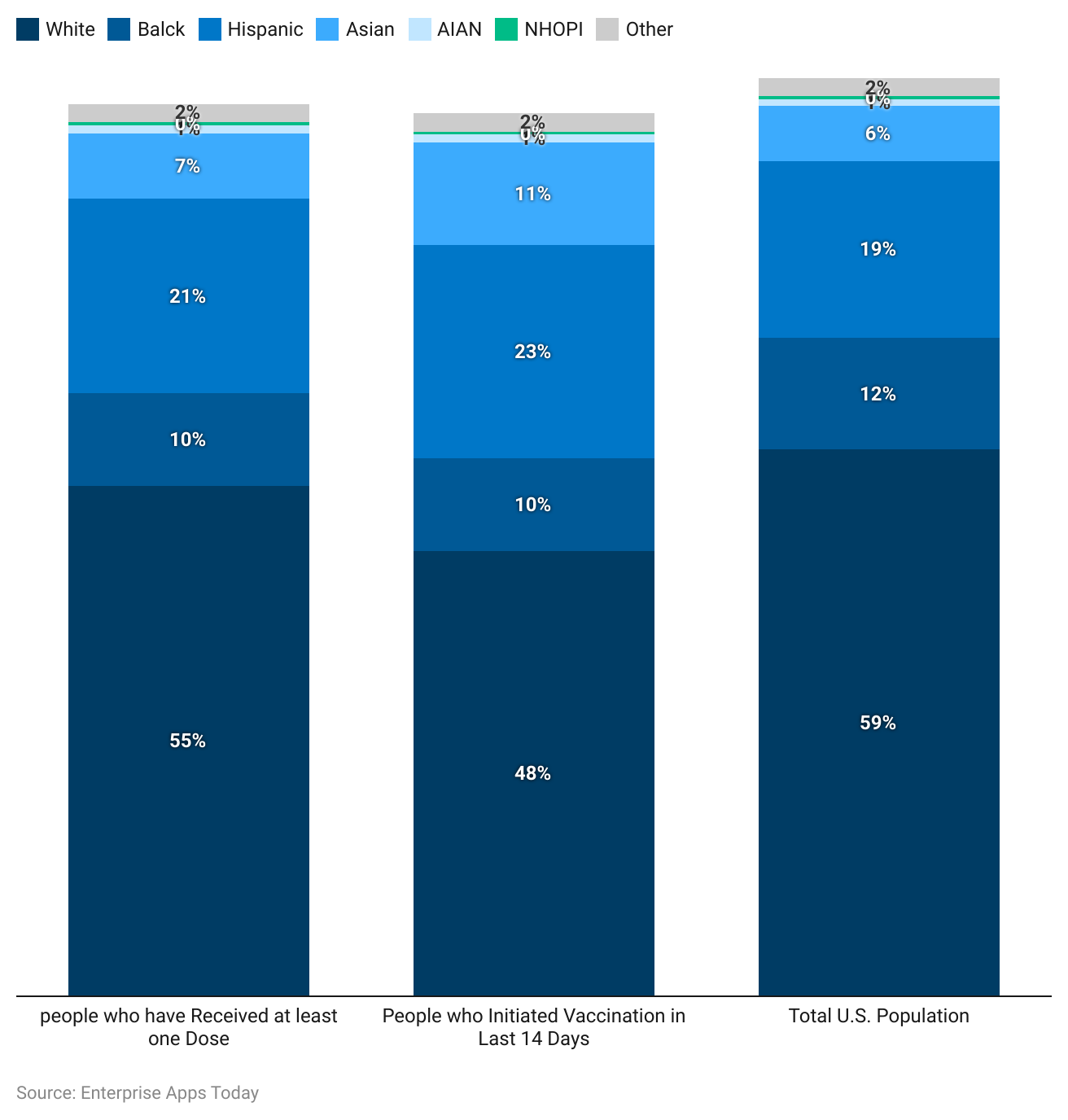
(Reference: kff.org)
- According to the Vaccine Statistics, the above chart explains insights into booster doses taken in the United States of America as of July 2022.
People who have received a booster dose
- White (61%)
- Black (8%)
- Hispanic (15%)
- Asian (8)
- AIAN (0.7%)
- NHOPI (0.03%)
- And other (3%)
People who have received a booster dose in the last 14 days
- White (45%)
- Black (11%)
- Hispanic (23%)
- Asian (11%)
- AIAN (1%)
- NHOPI (0.4%)
- And other (5%)
Fully vaccinated people
- White (56%)
- Black (10%)
- Hispanic (20%)
- Asian (7%)
- AIAN (0.9%)
- NHOPI (0.3%)
- And other (2%)
Vaccine Statistics By State
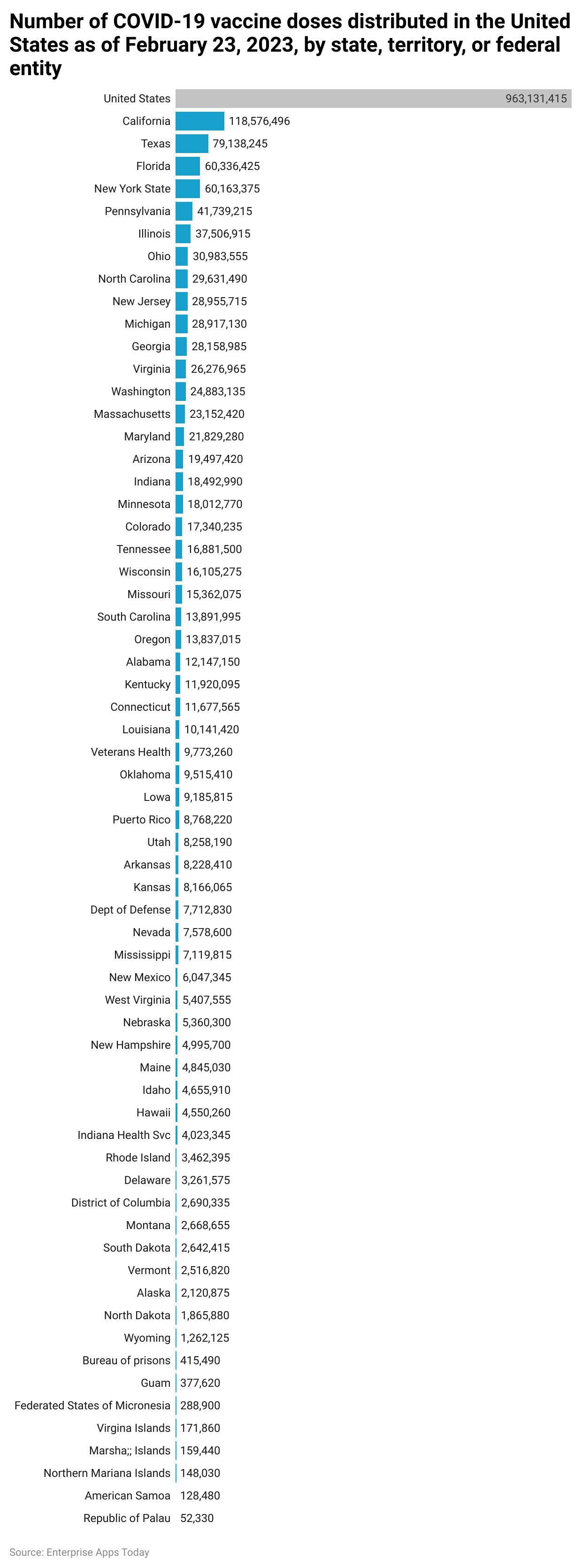
(Reference: Statista.com)
- In the United States of America, as of February 2023, 963,131,415 million vaccines have been distributed.
- The top three states with which highest number of vaccines are California (118,576,495), Texas (79,138,245), and Florida (60,336,425).
- On the other hand, the states with the lowest number of vaccines distributed as of February 2023 are the Northern Mariana Islands (148,030), American Samoa (128,480), and the Republic of Palau (52,330).
Vaccine Statistics By Type
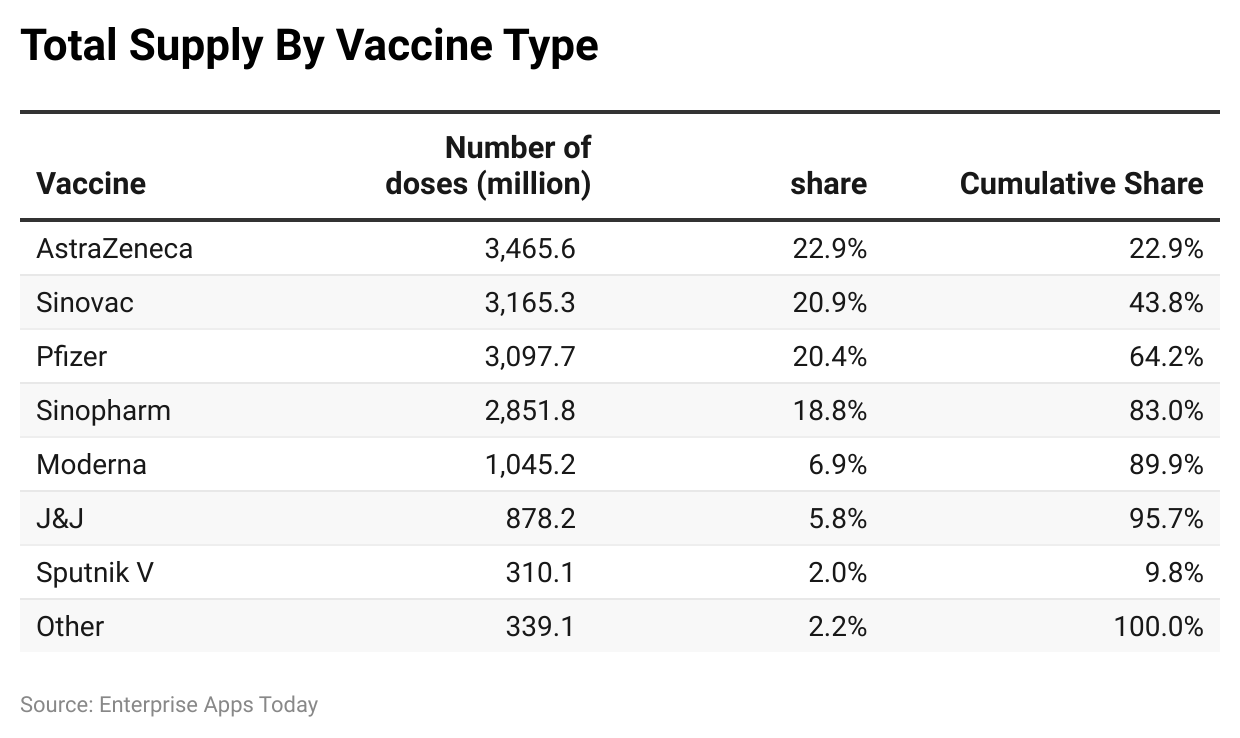
(Reference: wto.org)
- Around the world, AstraZeneca has the highest number of supplied doses resulting in 3,465.6 million with a cumulative share in the market of 22.9%.
- Sinovac supplied 3,165.3 million doses with 43.8% of the cumulative share.
- Other vaccines recorded the following data: Pfizer- 3,097.7 million (64.2%), Sinopharm – 2,851.8 million (83%), Moderna 1,045.2 million (89.9%), J&J 878.2 (95.7%), Sputnik V 310.1 million (97.8%) and other vaccines 339.1 million (100%).
Vaccine Statistics By Purpose
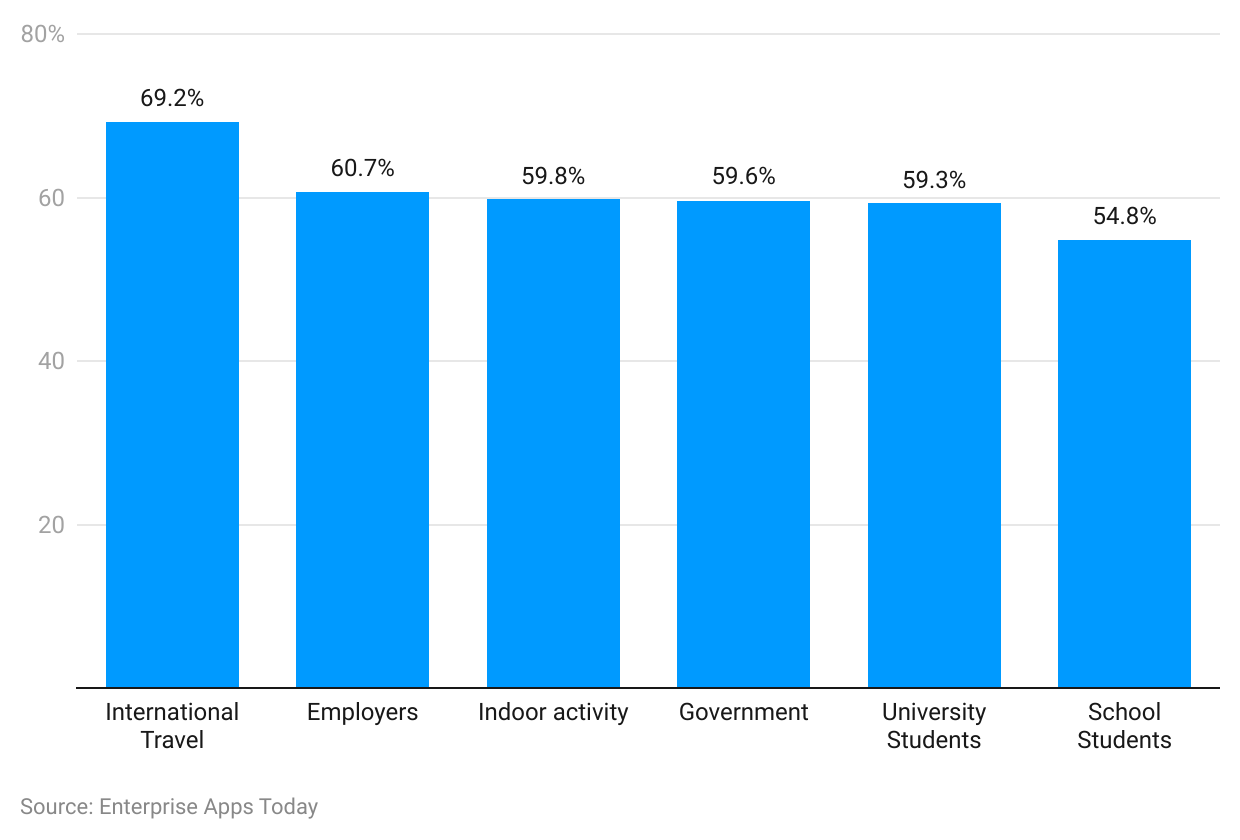
(Reference: Statista.com)
- Around the globe, Vaccine Statistics report that the maximum number of people took vaccination because of international travel resulting in 69.2%.
- The second most common reason provided was because of the companies and the employers resulting in 60.7%.
- Around 59.8% and 59.6% immunized themselves because of indoor activity and government rules respectively.
- 3% of the population around the globe got themselves vaccinated because of the Universities they were studying in and 54.8% population gave reason because of their school.
Vaccine Statistics By Exports
By Producing Countries
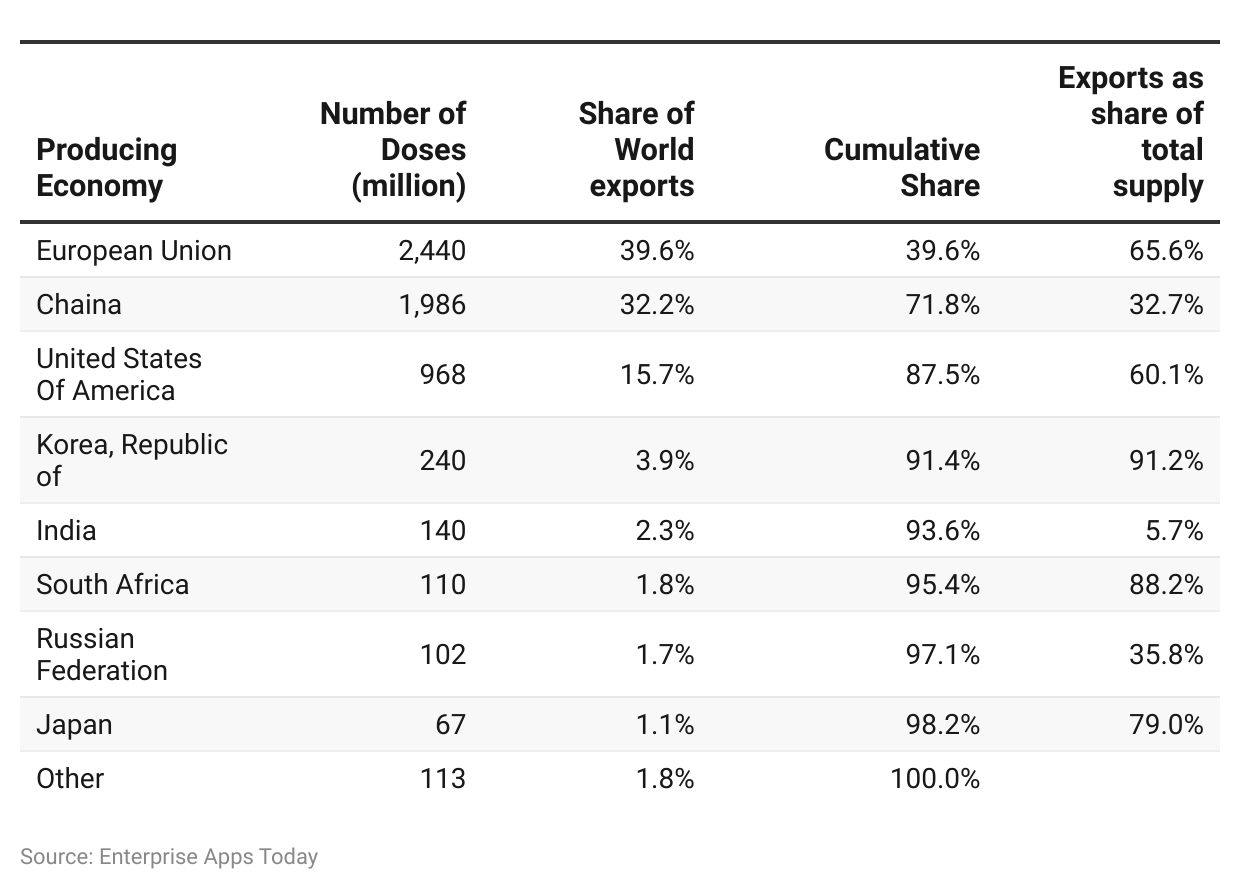
(Reference: wto.org)
- European Union stood at the top for producing 39.6% of the total share in world export of the total number of vaccines resulting in 2,440.4 million.
- Furthermore, the following countries also ranked in the list for producing the stated number of total vaccine doses.
- China: produced doses- 1,986.4 million Share in world exports (32.2%), United States of America: produced doses- 968 million Share in world exports (15.7%), Korean Republic: produced doses- 240.4 million Share in world exports (3.9%), India: produced doses- 140.2 million Share in world exports (2.3%), South Africa: produced doses- 110.4 million Share in world exports (1.8%), Russian Federation: produced doses- 102.4 million Share in world exports (1.7%), Japan: produced doses- 67 million Share in world exports (1.1%), and other countries: produced doses- 113.4 million Share in world exports (1.8%),
Vaccine Statistics By Imports
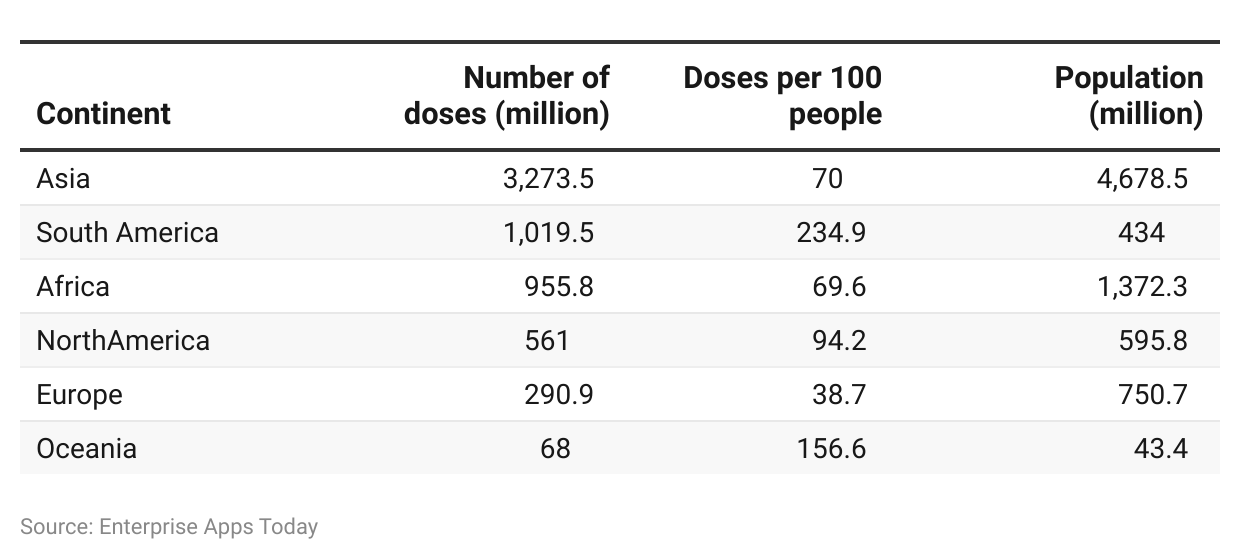
(Reference: wto.org)
- As per the Vaccine Statistics, in Asia compared to the 4,678.5 million population only 3,273.5 million COVID-19 vaccine doses were imported, the total available doses for every 100 people resulted in 70.
- In South America and North America around 1,019.5 million and 561 million doses were imported as compared to the population of 434 million and 595.8 million respectively.
- Whereas imports made by Africa, Europe, and Oceania were 955.8 million, 290.9 million, and 68 million compared to 1,372.3 million, 750.7 million, and 43.4 million resulting in 69.6, 38.7, and 156.5 doses for every 100 people.
Vaccine Statistics By Country
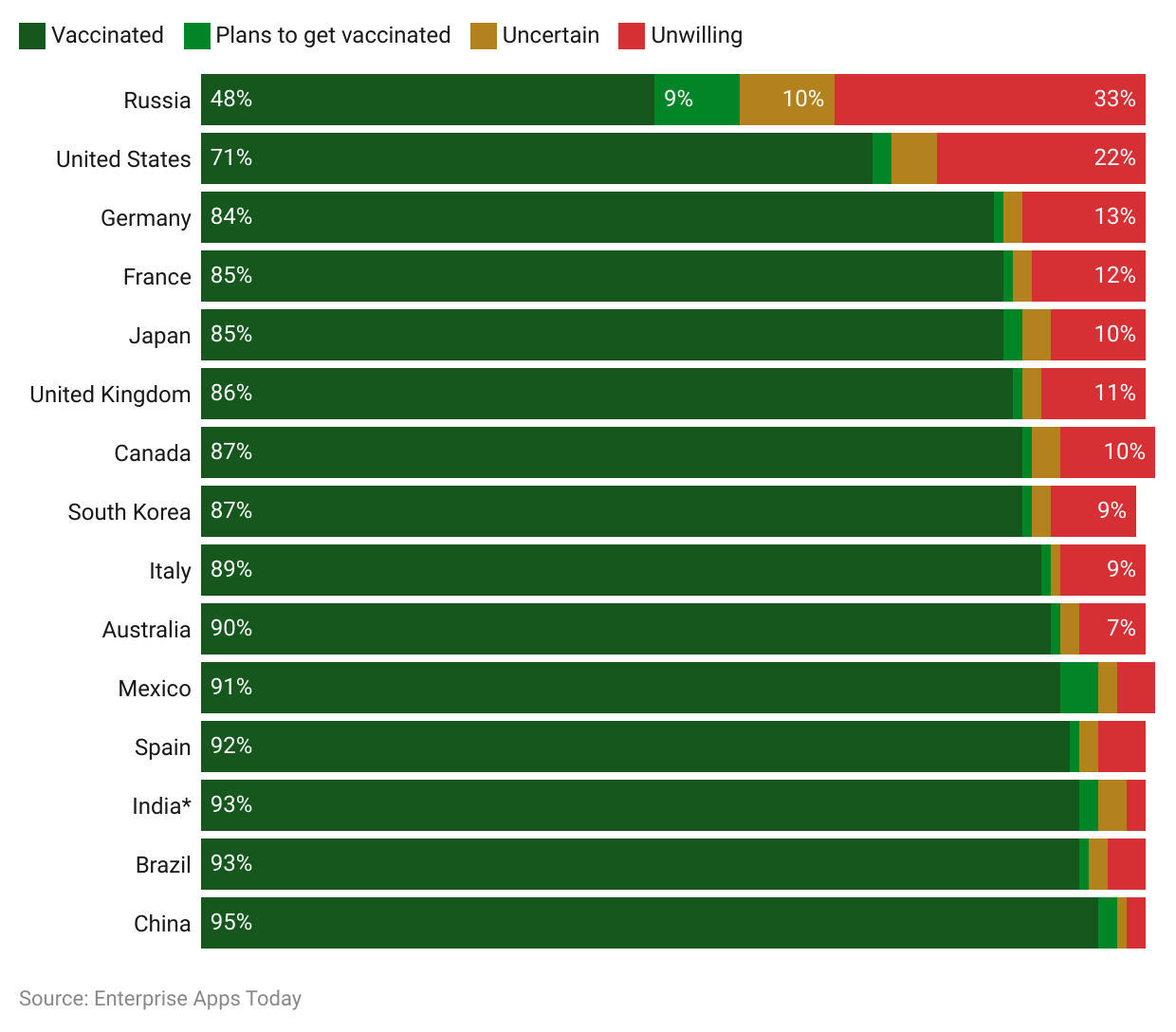
(Source: morningconsult.com)
- As of February 2023, Vaccine Statistics state that there are yet many countries where a small number of people are not vaccinated, following are the insights into such countries.
Russia
- Vaccinated (48%)
- Planning to get vaccinated (9%)
- Uncertain (10%)
- Unwilling (33%)
United States of America
- Vaccinated (71%)
- Planning to get vaccinated (2%)
- Uncertain (5%)
- Unwilling (22%)
Germany
- Vaccinated (84%)
- Planning to get vaccinated (2%)
- Uncertain (2%)
- Unwilling (13%)
France
- Vaccinated (85%)
- Planning to get vaccinated (2%)
- Uncertain (2%)
- Unwilling (12%)
Japan
- Vaccinated (85%)
- Planning to get vaccinated (2%)
- Uncertain (3%)
- Unwilling (10%)
United Kingdom
- Vaccinated (86%)
- Planning to get vaccinated (2%)
- Uncertain (2%)
- Unwilling (11%)
Canada
- Vaccinated (87%)
- Planning to get vaccinated (2%)
- Uncertain (3%)
- Unwilling (10%)
South Korea
- Vaccinated (87%)
- Planning to get vaccinated (2%)
- Uncertain (2%)
- Unwilling (9%)
Italy
- Vaccinated (89%)
- Planning to get vaccinated (1%)
- Uncertain (1%)
- Unwilling (9%)
Australia
- Vaccinated (90%)
- Planning to get vaccinated (1%)
- Uncertain (2%)
- Unwilling (7%)
Mexico
- Vaccinated (91%)
- Planning to get vaccinated (4%)
- Uncertain (4%)
- Unwilling (4%)
Spain
- Vaccinated (92%)
- Planning to get vaccinated (2%)
- Uncertain (2%)
- Unwilling (5%)
India
- Vaccinated (93%)
- Planning to get vaccinated (2%)
- Uncertain (3%)
- Unwilling (2%)
Brazil
- Vaccinated (93%)
- Planning to get vaccinated (1%)
- Uncertain (2%)
- Unwilling (4%)
China
- Vaccinated (95%)
- Planning to get vaccinated (2%)
- Uncertain (1%)
- Unwilling (2%)
Vaccine Statistics By Industry
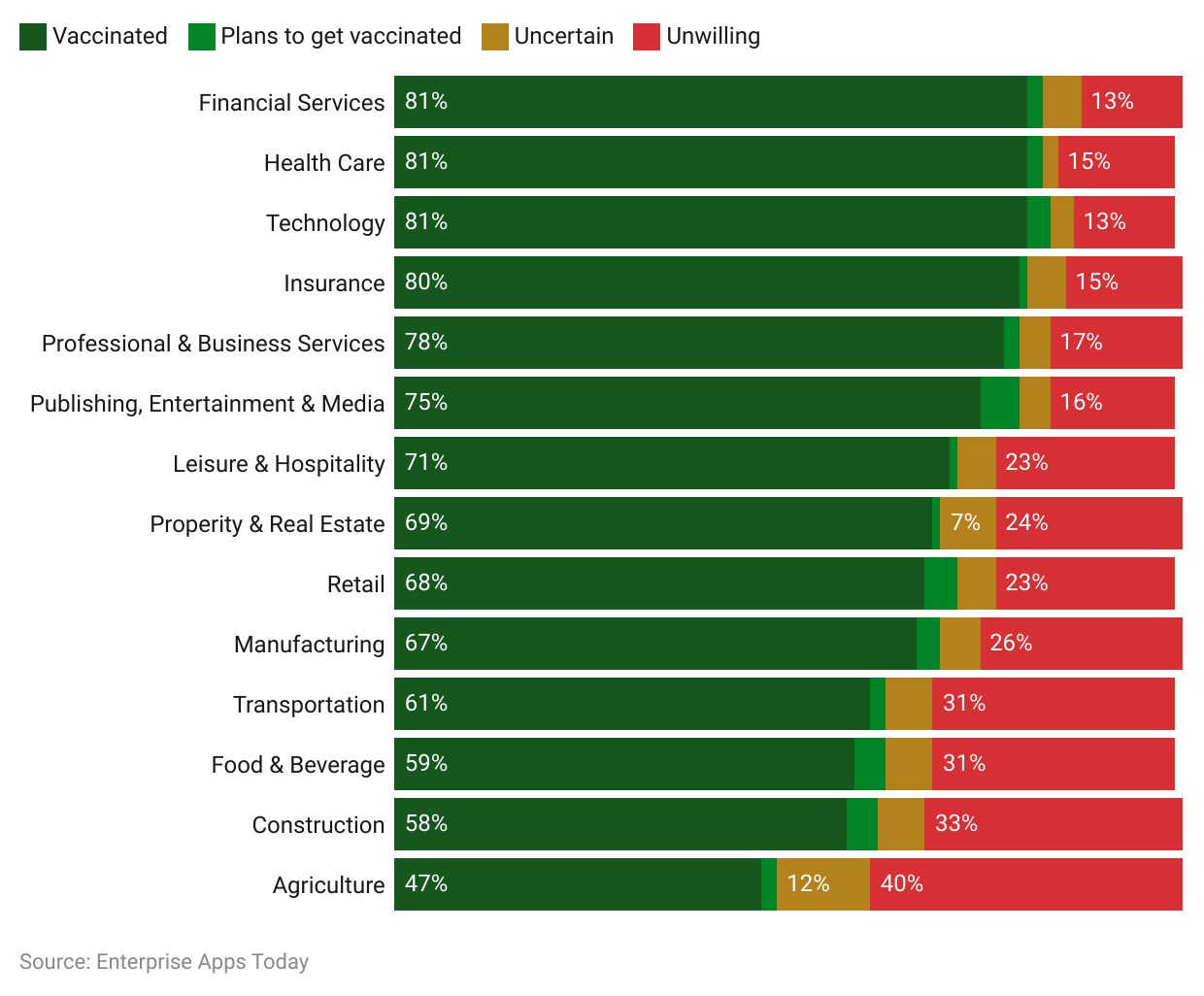
(Reference: morningconsult.com)
- The above chart explains the Vaccine Statistics according to the industry as of February 2023. The following is an industry-wise explanation of vaccination status:
Financial Service
- Vaccinated (81%)
- Planning to get vaccinated (2%)
- Uncertain (5%)
- Unwilling (13%)
Health Care
- Vaccinated (81%)
- Planning to get vaccinated (2%)
- Uncertain (2%)
- Unwilling (15%)
Technology
- Vaccinated (81%)
- Planning to get vaccinated (3%)
- Uncertain (3%)
- Unwilling (13%)
Insurance
- Vaccinated (80%)
- Planning to get vaccinated (1%)
- Uncertain (5%)
- Unwilling (15%)
Professional and Business Services
- Vaccinated (78%)
- Planning to get vaccinated(2%)
- Uncertain (4%)
- Unwilling (17%)
Publishing, Entertainment, and Media
- Vaccinated (75%)
- Planning to get vaccinated (5%)
- Uncertain (4%)
- Unwilling (16%)
Leisure and Hospitality
- Vaccinated (71%)
- Planning to get vaccinated (1%)
- Uncertain (5%)
- Unwilling (23%)
Property and real estate
- Vaccinated (69%)
- Planning to get vaccinated (1%)
- Uncertain (7%)
- Unwilling (24%)
Retail
- Vaccinated (68%)
- Planning to get vaccinated (4%)
- Uncertain (5%)
- Unwilling (23%)
Manufacturing
- Vaccinated (67%)
- Planning to get vaccinated (3%)
- Uncertain (5%)
- Unwilling (26%)
Transportation
- Vaccinated (61%)
- Planning to get vaccinated (2%)
- Uncertain (6%)
- Unwilling (31%)
Food and beverage
- Vaccinated (59%)
- Planning to get vaccinated (4%)
- Uncertain (6%)
- Unwilling (31%)
Construction
- Vaccinated (58%)
- Planning to get vaccinated (4%)
- Uncertain (6%)
- Unwilling (33%)
Agriculture
- Vaccinated (47%)
- Planning to get vaccinated (2%)
- Uncertain (12%)
- Unwilling (40%)
Conclusion
Vaccines, whether it is a recent pandemic such as covid-19 or just polio, provide a great way to shield your body from getting affected. According to these Vaccine statistics, there are many people who have unfortunately not injected themselves with immunization. And the researchers say, a pandemic is never going to go away and we need to live with it, therefore, it is important to stay safe and get vaccinated timely to reduce the effects.
Sources
FAQ.
Following are the types of vaccines: Toxoid, Viral Vector, Messenger RNA (mRNA), Live Attenuated, Inactivated, Subunit, recombinant, conjugate, and polysaccharide vaccines.
Vaccines prevent deaths and can stop viruses or diseases in the body from growing. Vaccines have the capacity to kill deadly viruses. There’s proof of decreasing the number of long-found diseases such as measles, smallpox, polio, etc. around the world.
Yes, in some cases it is possible that you may get affected if you have a low immune system. But the dangerous after-effects will be lowered by the vaccines therefore, there’s a low risk of death or need for hospitalization.
Vaccines prevent deaths and can stop viruses or diseases in the body from growing. Vaccines have the capacity to kill deadly viruses. There’s proof of decreasing the number of long-found diseases such as measles, smallpox, polio, etc. around the world.

By conducting scientific research, I write about illness, health and healthcare. As a professional medical writer, my experience includes creating feature articles for newsletters and websites as well as research news stories for doctors and researchers. Reading has been an integral part of me since childhood - I'm fan of "Friends" and the "Harry Potter series". Before this career, I was employed by a French multinational company. However, my passion for reading led me to pursue writing professionally; my first Amazon-published short story entitled "The envelope that changed our lives" has recently been released. In my free moments, I enjoy long bike rides around town.